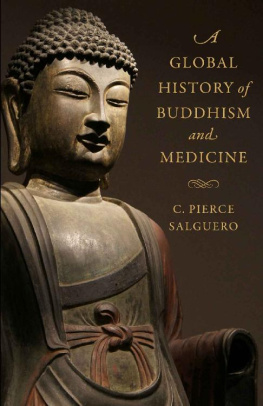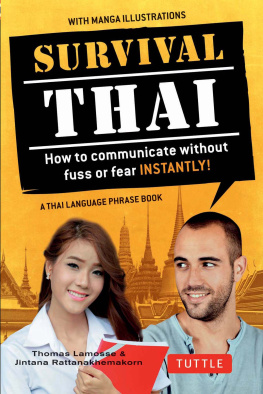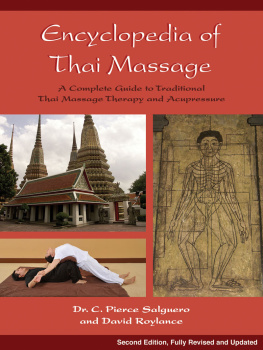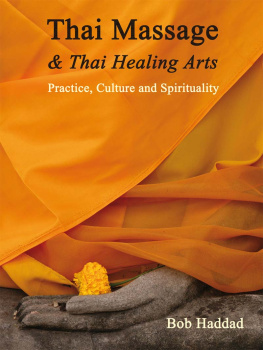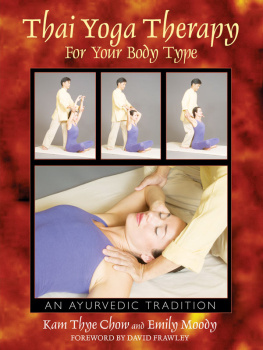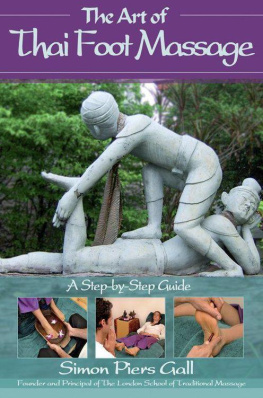Companion Book Available

978-1-84409-564-3
available from your local bookstore,
or directly from publisher at
www.findhornpress.com
All materials unless otherwise attributed:
1997-2011 C. Pierce Salguero
The rights of C. Pierce Salguero to be identified as the author of this work have been
asserted by him in accordance with the Copyright, Designs and Patents Act 1998.
First published by Findhorn Press 2004. Second edition, fully revised and updated,
published by Findhorn Press 2011.
ISBN: 978-1-84409-563-6
All rights reserved. The contents of this book may not be reproduced in any form,
except for short extracts for quotation or review, without the written permission
of the publisher.
British Library Cataloguing-in-Publication Data.
A catalogue record for this book is available from the British Library.
Massage photography by Keith Edwards of Statesider Photography
(www.statesider.com), 2011 David Roylance.
Special thanks to our models Viengkhong Khambay and Ketsarin Phaopanfeung,
who volunteered their hard work for this book.
Anatomical drawings 2001-2011 David O. Schuster
Yoga Correlations 2004-2011 Kate Hallahan, RYT
Edited by Nicky Leach
Cover design by Richard Crookes
Interior design by Damian Keenan
Printed and bound in China
1 2 3 4 5 6 7 8 9 10 20 19 18 17 16 15 14 13 12 11
Published by
Findhorn Press
117-121 High Street,
Forres IV36 1AB Scotland,
United Kingdom
t +44-(0)1309-690582
f +44(0)131-777-2711
e
www.findhornpress.com

In Memory of
Ajahn (Master) Sintorn Chaichakan
Traditional Thai Medicine Doctor
Founder of Shivagakomarpaj Lineage
(Northern Style Thai Massage)
Founder of Thai Massage School Shivagakomarpaj
(Old Medicine Hospital)
August 2,1939 - October 18, 2005
THROUGHOUT the long history of Thai Massage and Traditional Thai Medicine, there have been a handful of highly respected individuals who have made exceptional contributions to the body of knowledge practiced today. This book is dedicated to the lasting memory of Ajahn Sintorn, who was one such person, and who originated the teachings shared here.
Ajahn Sintorns life was dedicated to pursuing knowledge and giving to others. He and his staff regularly provided free medical care to Buddhist monks and remote Thai villagers. He operated his traditional hospital based on a sliding scale to ensure all those who needed medical attention could be treated. His life and his legacy exemplify compassion in care for others, generosity in teaching, and loving kindness to all.
We, Ajahn Sintorns family, and the direct inheritors of his lineage and school, would like to express our deepest appreciation and respect for Ajahn Sintorns lifetime of teachings. He is our link to the past and he will continue to live on in our hearts and our mind. We would also like to express our endorsement of this book. We are very pleased to see his teachings honored and reaching those outside of Thailand. We believe that our past is our future, and that Ajahn Sintorns teachings are vibrantly alive in the hands of the next generation.

Ajahn Wasan Chaichakan
Director

Mr. Parawat Poungpiam
Managing Director
Contents

Preface

T HIS IS A COMPREHENSIVE book about one of the main branches of Traditional Thai Medicine, known in the West as Thai Massage. The manipulation of the body with intent to heal is a practice probably as old as the human body itself. The instincts to press ones head when it aches or to rub a sore calf muscle lie at the foundation of this healing technique. Historically, this natural instinct for healing touch has been developed and systematized to a high degree in many Asia cultures, where massage is an important part of systems of traditional medicine.
In Siam (premodern Thailand), indigenous medical practices, including massage, intermingled with Chinese and Indian influences and developed into a complex medical tradition encompassing therapy for the mind, body, and vital energies. Long preserved in Buddhist temples, which served as community centers and cultural libraries, Thai medical wisdom was transmitted from teacher to student through oral and written tradition, resulting in the fascinating amalgam of mythology, medicine, and spirituality that is still practiced today across the country.
This book will cover many aspects of Thai Massage, based on my experience as a teacher of Thai medicine since the mid-1990s. I first attended and later taught at a bilingual traditional medicine school, the Thai Massage School Shivagakomarpaj (Old Medicine Hospital) in Chiang Mai. In 1997, Ajahn Sintorn wrote me a letter recognizing me as a teacher and granted me permission to disseminate his teachings in the West. I also studied with many other teachers, both well known and otherwise, while living in Thailand for 26 months over the course of the 1990s and early 2000s. Upon my return to the United States in 2001, I founded the Tao Mountain School of Traditional Thai Massage and Herbal Medicine, which merged with the Thai Institute of Healing Arts in 2009.
I should say at the outset that any of my teachers would say it is impossible to learn from a book without hands-on guidance, and I would agree. The oral tradition is still honored in Thailand to this day, and most massage teachers operate by verbally explaining and physically demonstrating each movement while their students listen and watch. Even in the massage schools that offered textbooks for their courses, the books are seldom more than a series of crude drawings. To this day, there has not been very much written on the subject of Thai medical theory, either by Thais or by Western practitioners, and a systematic explanation of the theory of Thai Massage is virtually impossible to come by. Massage teachers in Thailand are unlikely to give direct answers to theoretical questions, and will expect the students instead to learn these answers through their own diligence, practice, and patience. Western aficionados of Thai massage impatient for deeper understanding often mistakenly apply Chinese, Indian, or biomedical theory to the practice, sometimes grossly distorting Thai tradition in the process.
Despite my best intentions to convey the techniques of Thai Massage as clearly as possible, the reader must realize that learning this massage from a book is a vastly different experience than learning with a traditional teacher. The structured lessons at the hospital were invaluable as a base of knowledge for further practice. In my own training, however, it was the contradictory and unstructured sessions with traditional practitioners outside of a formal institutional setting that allowed me to experience this knowledge as a true art. Like transitioning from learning scales to playing jazz improvisations, or from drilling on basketball skills to becoming a star professional player, these masters had internalized their techniques so deeply that rote learning had given way to intuition. It was watching the graceful dances of these teachers as they worked with patients that instilled in me an everlasting respect and love for their priceless cultural heritage.


